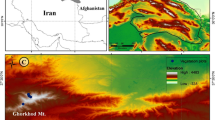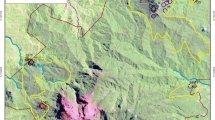Abstract
Localized ultramafic outcrops in Kinabalu Park (encompassing Mount Kinabalu and Mount Tambuyukon) in Sabah (Malaysia) are known for high levels of plant diversity and endemism, which have been stimulated by extreme soil chemistry and biogeographic factors, such as isolation. Characteristic of these outcrops are edaphic endemics of insectivorous pitcher plants from the Nepenthaceae-family including Nepenthes burbidgeae, N. edwardsiana, N. macrovulgaris, N. rajah and N. villosa, all of which (except N. macrovulgaris) are confined solely to the protected area of Kinabalu Park. Although the various aspects of plant taxonomy and nutrition of this genus have been extensively studied, the habitat of these rare species has to date not been studied in detail. It was hypothesized that while the Nepenthes of Mount Kinabalu and Mount Tambuyukon are excluders of excess trace elements, soil chemistry is nevertheless a major driver for creating the specific habitats in which ultramafic edaphic endemic Nepenthes occur, and that this is reflected in vegetation physiognomy and co-occurring species composition as well as in the foliar chemistry of Nepenthes. The results show that the characteristics of the physical environment and soil chemistry ‘induces’ a vegetation physiognomy that varies among sites and produces a series of different niches that are colonised by different Nepenthes-species. Although other plant species associated with these niches do not directly influence the distributions of the Nepenthes-species, some are characteristic. The unusual ultramafic soil chemistry is not reflected in the foliar chemistry of Nepenthes and they appear to be ‘Excluders’ of potentially toxic soil trace element concentrations. The populations of Nepenthes burbidgeae, N. edwardsiana, N, rajah, N. villosa are small (in particular, N. burbidgeae) and these species are thus likely to be vulnerable to the potential effects of climate change-induced drought and fire.







Similar content being viewed by others
References
Acres BD (1972) The ascent of Trus Madi. Sabah Soc J 5:365–370
Adamec L (1997) Mineral nutrition of carnivorous plants: a review. Bot Rev 63:273–299
Adlassnig W, Steinhauser G, Peroutka M, Musilek A, Sterba JH, Lichtscheidl IK, Bichler M (2009) Expanding the menu for carnivorous plants: uptake of potassium, iron and manganese by carnivorous pitcher plants. Appl Radiat Isot 67:2117–2122
Aiba S, Kitayama K (1999) Structure, composition and species diversity in an altitude-substrate matrix of rain forest tree communities on Mount Kinabalu, Borneo. Plant Ecol 140:139–157
Ashton PS (2003) Floristic zonation of tree communities on wet tropical mountains revisited. Perspect Plant Ecol 6:87–104
Baker AJM (1981) Accumulators and excluders - strategies in the response of plants to heavy metals. J Plant Nutr 3(1–4):643–654
Bauer U, Di Giusto, B, Skepper J, Grafe TU, Federle W (2012) With a flick of the lid: a novel trapping mechanism in Nepenthes gracilis Pitcher Plants. (J. Ollerton, ed). PLoS One Jun 13, 2012, doi: 10.1371/journal.pone.0038951
Beaman JH, Beaman RS (1990) Diversity and distribution patterns in the flora of Mount Kinabalu. In: Kalkman K, Geesink R (eds) Baas P. The plant diversity of Malesia, Kluwer Academic Publishers, pp 147–160
Becquer T, Bourdon E, Pétard J (1995) Disponibilité du nickel le long d’une toposéquence de sols développés sur roches ultramafiques de Nouvelle-Calédonie. Cr Acad Sci Ii A 321(7):585–592
Brooks RR (1987) Serpentine and its vegetation: a multidisciplinary approach. Dioscorides Press, Portland, p 462
Bruijnzeel LH, Waterloo M, Proctor J, Kuiters A, Kotterink B (1993) Hydrological observations in montane rain forests on Gunung Silam, Sabah, Malaysia with special reference to the ‘Massenerhebung’ effect. J Ecol 81:145–167
Chandler GE, Anderson JW (1976) Studies on the nutrition and growth of Drosera species with reference to the carnivorous habit. New Phytol 76:129–141
Chin L, Moran JA, Clarke C (2010) Trap geometry in three giant montane pitcher plant species from Borneo is a function of tree shrew body size. New Phytol 186(2):461–470
Chin L, Chung AYC, Clarke C (2014) Interspecific variation in prey capture by co-occurring Nepenthes pitcher plants—evidence for resource partitioning or sampling scheme artefacts? Plant Signal Behav 9:e27930
Clarke CM (1997) Nepenthes of Borneo. Natural History Publications (Borneo), Kota Kinabalu
Clarke CM, Bauer U, Lee CC, Tuen AA, Rembold K, Moran JA (2009) Tree shrew lavatories: a novel nitrogen sequestration strategy in a tropical pitcher plant. Biol Lett 5(5):632–635
Dohrmann R (2006) Cation exchange capacity methodology II: a modified silver-thiourea method. Appl Clay Sci 34(1–4):38–46
Ellison AM (2006) Nutrient limitation and stoichiometry of carnivorous plants. Plant Biol 8(6):740–747
Ellison AM, Farnsworth EJ (2005) The cost of carnivory for Darlingtonia californica (Sarraceniaceae): evidence from relationships among leaf traits. Am J Bot 92:1085–1093
Givnish TJ, Burkhardt EL, Happel RE, Weintraub JD (1984) Carnivory in the bromeliad Brocchinia reducta, with a cost/benefit model for the general restriction of carnivorous plants to moist, sunny, nutrient–poor habitats. Am Nat 124:479–497
Greenwood M, Clarke C, Lee CC, Gunsalam A, Clarke RH (2011) A unique resource mutualism between the Giant Bornean Pitcher Plant, Nepenthes rajah, and members of a small mammal community. PLoS One 6(6):e21114. doi:10.1371/journal.pone.0021114.g003
Grubb P, Whitmore T (1966) A comparison of montane and lowland rain forest in Ecuador: II. The climate and its effects on the distribution and physiognomy of the forests. J Ecol 54:303–333
Juniper BE, Robins RJ, Joel DM (1989) The carnivorous plants. Academic Press, London
Kazakou E, Dimitrakopoulos PG, Baker AJM, Reeves RD, Troumbis AY (2008) Hypotheses, mechanisms and trade-offs of tolerance and adaptation to serpentine soils: from species to ecosystem level. Biol Rev 83(4):495–508
Kitayama K, Lakim M, Wahab MZ (1999) Climate profile of Mount Kinabalu during late 1995—early 1998 with special reference to the 1998 drought. Sabah Parks Nat J 2:85–100
Lindsay WL, Norvell WA (1978) Development of DTPA soil test for zinc, iron, manganese, and copper. Soil Sci Soc Am J 42:421–428
McPherson SR (2011) New Nepenthes, vol 1. Redfern Natural History Productions, Poole
Mehlich A (1984) Mehlich-3 soil test extractant: a modification of Mehlich-2 extractant. Commun Soil Sci Plan 15(12):1409–1416
Moran JA, Clarke C, Greenwood M, Chin L (2012) Tuning of color contrast signals to visual sensitivity maxima of tree shrews by three Bornean highland Nepenthes species. Plant Signal Behav 7(10):1267–1270
Olsen SR, Cole CV, Watanabe FS, Dean LA (1954) Estimation of available phosphorus in soils by extraction with sodium bicarbonate. USDA Circular 939, Gov. Printing Office Washington D.C, USA, pp 1–19
Osunkoya OO, Daud SD, Di-Guisto B, Wimmer FL, Holige TM (2007) Construction costs and physico-chemical properties of the assimilatory organs of Nepenthes in northern Borneo. Ann Bot 99:895–906
Proctor J (2003) Vegetation and soil and plant chemistry on ultramafic rocks in the tropical Far East. Perspect Plant Ecol Evol Syst 6(1–2):105–124
Proctor J, Lee YF, Langley AM, Munro W, Nelson T (1988) Ecological studies on Gunung Silam, a small ultrabasic mountain in Sabah, Malaysia. I. Environment, forest structure and floristics. J Ecol 76(2):320–340
Reeves RD (2003) Tropical hyperaccumulators of metals and their potential for phytoextraction. Plant Soil 249(1):57–65
Stewart CN, Nilsen ET (1993) Responses of Drosera capensis and D. binata var. multifida (Droseraceae) to manipulations of insect availability and soil nutrient levels. New Zeal J Bot 31:385–390
Wakefield AE, Gotelli NJ, Wittman SE, Ellison AM (2005) The effect of prey addition on nutrient stoichiometry, nutrient limitation, and morphology of the carnivorous plant Sarracenia purpurea (Sarraceniaceae). Ecology 86:1737–1743
Wells K, Lakim MB, Schulz S, Ayasse M (2011) Pitchers of Nepenthes rajah collect faecal droppings from both diurnal and nocturnal small mammals and emit fruity odour. J Trop Ecol 27(04):347–353
Wright IJ, Reich PB, Westoby M, Ackerly DD, Baruch Z, Bongers F, Cavender-Bares J, Chapin T, Cornelissen JHC, Diemer M, Flexas J, Garnier E, Groom PK, Gulias J, Hikosaka K, Lamont BB, Lee T, Lee W, Lusk C, Midgley JJ, Navas M-L, Niinemets Ü, Oleksyn J, Osada N, Poorter H, Poot P, Prior L, Pyankov VI, Roumet C, Thomas SC, Tjoelker MG, Veneklaas EJ, Rafael Villar R (2004) The worldwide leaf economics spectrum. Nature 428:821–827
Acknowledgments
We wish to thank Rimi Repin and Rositti Karim (Sabah Parks) and John Sugau and Postar Miun (Sabah Forestry Department) for their support. We wish to express our gratitude to the Sabah Biodiversity Centre, Sabah Parks and the Sabah Forestry Department for granting permission to conduct research in Sabah.
Author information
Authors and Affiliations
Corresponding author
Additional information
Communicated by Thomas Abeli.
Electronic supplementary material
Below is the link to the electronic supplementary material.
Supplementary Table 1
Plot census with number of Nepenthes individuals per species and environmental attribute data
Rights and permissions
About this article
Cite this article
van der Ent, A., Sumail, S. & Clarke, C. Habitat differentiation of obligate ultramafic Nepenthes endemic to Mount Kinabalu and Mount Tambuyukon (Sabah, Malaysia). Plant Ecol 216, 789–807 (2015). https://doi.org/10.1007/s11258-015-0468-6
Received:
Accepted:
Published:
Issue Date:
DOI: https://doi.org/10.1007/s11258-015-0468-6




